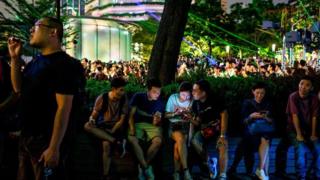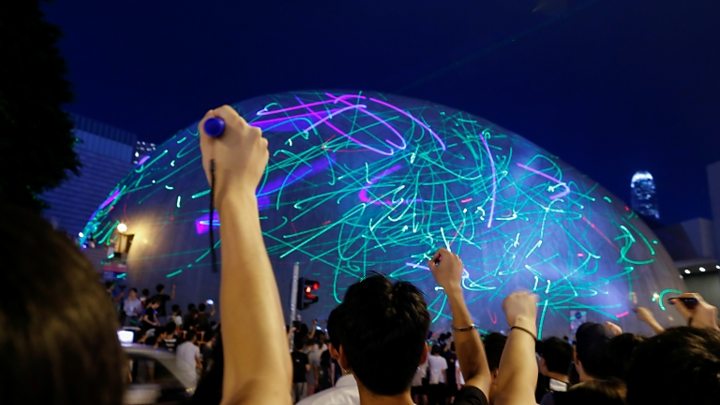Hong Kong Protesters Turn To Uber And Pokemon
 Image copyright
Getty Images
Image copyright
Getty Images
In late July, Hong Kong protesters returning from a demonstration were attacked by a group of men wearing white shirts. Soon afterwards, anonymous adverts appeared online calling for a mass Pokemon Go hunt in a town where the suspected attackers had congregated a week earlier.
"If we said that we were going to an unauthorised protest it would have provided good evidence for the police to charge us," said KK, an office worker and protester in his late 20s, who asked for his identity to be protected.
Thousands of protesters gathered at the location, recognising that the video game - which lets players pit virtual monsters against each other at real-world locations - had been used as a way to gather people together for a very different kind of battle.
Crowds were eventually dispersed with tear gas as police and protesters clashed into the late evening.
"Many people think of creative ways to gather people," KK added.
"We will occasionally 'play' Pokemon Go, or take part in 'Bible reading groups' or 'history tours'."
Mass demonstrations against a now-suspended extradition bill started in Hong Kong in the spring. Among the protesters' demands are amnesty for anyone arrested during the demonstrations and greater choice in future elections held in the semi-autonomous city.
And they are are finding increasingly creative ways to organise and stage their rallies.
From chats on the private messaging app Telegram to Uber's ride-hailing service, apps have become an integral part of the way that Hong Kong's youth-led movement is organised.
On packed subways, protesters anonymously send freshly-designed posters via Apple's wi-fi and Bluetooth-based file-transfer facility AirDrop - to share times and locations.
"At the very early stage of the movement, Telegram was mostly used to spread information to protesters," said Rob, a university graduate and active protester in his 20s.
"Information typically included real-time locations of the police force, the situations at different front lines on different streets and locations of first aid stations, gas masks, goggles, bottles of water."
Now, he explained, it is frequently used to place orders for Uber pick-ups. The drivers disable their GPS (global positioning system) receivers to avoid being tracked as they offer rides home to protesters who need to leave the scene.
"Volunteer drivers now submit their location, destination and licence number to the admin of the [relevant Telegram] channel," says Rob.
"Protesters can see from the real-time map - Uber drivers at the same location usually means pick-up points... to get away."
Another protester, who wanted to be known as NA7PNQ, added that he recently used Uber to travel through various different protest sites, picking up protesters needing to be "evacuated".
The Abacus news site has also reported that the dating app Tinder has been used to help organise events.
Alex, a full-time protester who quit his job to focus on the movement. said he would not leave home without a smartphone and a portable charger.
"Information on police's location from the scouts are key to reach protest location or escape without being caught," he explained.
"On the protest day, I do what I do best in the field, in the front line, and in other days I help reviewing our actions, making promotion materials.
"We have friends who live in foreign countries to share it on Facebook and WhatsApp. But we won't do it ourselves as it is just too risky."
On the ground, protesters also make use of an anonymous Hong Kong forum called Lihkg.
It helps them arrange to share out specific tasks. Rob specialises in putting out tear gas canisters fired by the police.
KK believes that the use of apps is key to the "leaderless nature" of the movement.
Since early June, police have arrested more than 500 protesters. The demonstrators say using online tools - which help them protect their anonymity - has helped avoid individuals being targeted.
"All of the people in the Umbrella Movement were jailed for inciting people to protest, now people tend not to be so open about encouraging people to protest," KK says, referencing the 2014 pro-democracy protests and subsequent imprisonment of their leaders.
Another resident compares the street battles to a last-player-standing video game popular in Hong Kong.

Media playback is unsupported on your device
"There is no-one in charge. They look like they are playing the mobile phone game PUGB [Player Unknown Battlegrounds]."
And while protesters are actually turning to games like Pokemon Go to push their agenda, they are also subverting its slogan - a point the same resident makes without apparently realising it.
"It's not easy for the police to catch all of them because they are not one organised group," he says.
"When the police catch one, they can only catch one team.
"They can't catch them all."
From Chip War To Cloud War: The Next Frontier In Global Tech Competition
The global chip war, characterized by intense competition among nations and corporations for supremacy in semiconductor ... Read more
The High Stakes Of Tech Regulation: Security Risks And Market Dynamics
The influence of tech giants in the global economy continues to grow, raising crucial questions about how to balance sec... Read more
The Tyranny Of Instagram Interiors: Why It's Time To Break Free From Algorithm-Driven Aesthetics
Instagram has become a dominant force in shaping interior design trends, offering a seemingly endless stream of inspirat... Read more
The Data Crunch In AI: Strategies For Sustainability
Exploring solutions to the imminent exhaustion of internet data for AI training.As the artificial intelligence (AI) indu... Read more
Google Abandons Four-Year Effort To Remove Cookies From Chrome Browser
After four years of dedicated effort, Google has decided to abandon its plan to remove third-party cookies from its Chro... Read more
LinkedIn Embraces AI And Gamification To Drive User Engagement And Revenue
In an effort to tackle slowing revenue growth and enhance user engagement, LinkedIn is turning to artificial intelligenc... Read more

